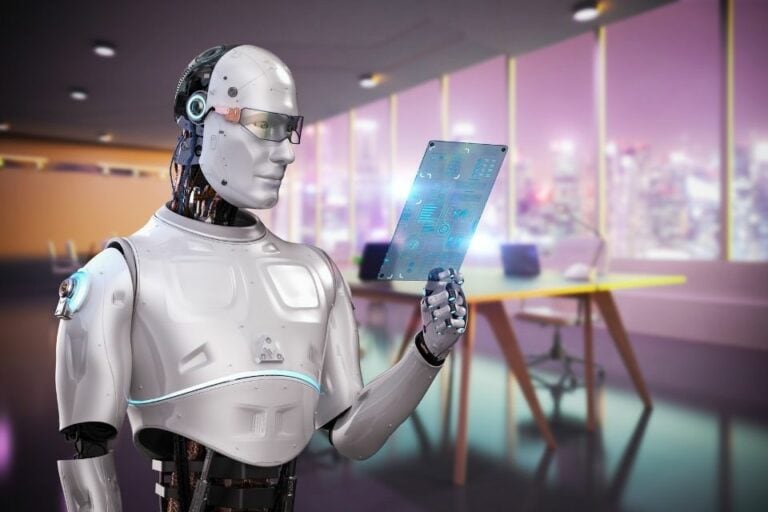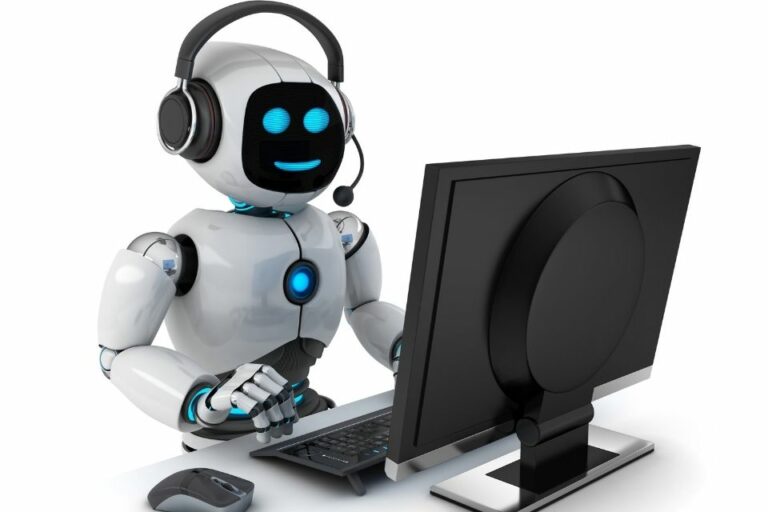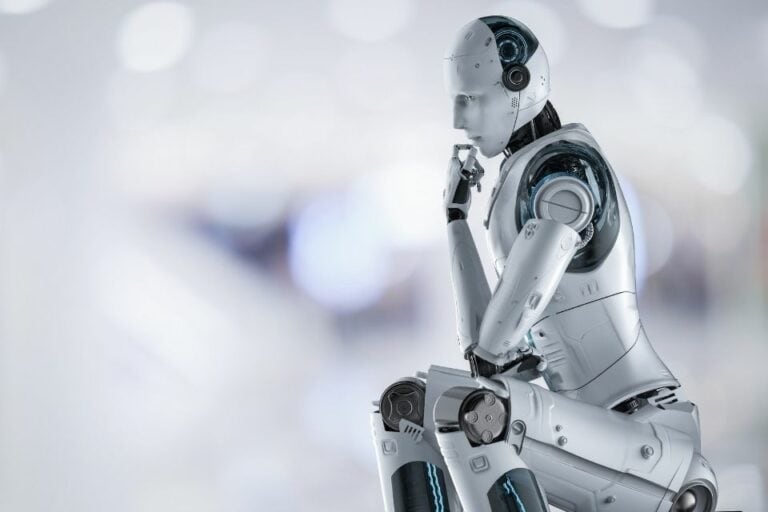Auto AI: 7 Proven Ways It’s Transforming Industries [2025]
Did you know that by 2030, it’s estimated that the global demand for industrial robots will increase by 175%? As industries continue to evolve and adapt to new technologies, automation has become a crucial aspect of their growth.
One of the most significant developments in this field is Auto AI, which uses artificial intelligence to automate various processes. Auto AI has transformed multiple industries, from manufacturing and healthcare to finance and agriculture.
With its ability to analyze vast amounts of data quickly, Auto AI can identify patterns and trends that would otherwise be impossible for humans to detect. This technology enables businesses to optimize their operations while minimizing errors, increasing efficiency, and reducing costs.
In this article, we’ll explore how Auto AI is transforming different sectors and shaping the future of work. So buckle up as we take a deep dive into this exciting world of automation!
Key Takeaways

- Auto AI is crucial for industries’ growth and efficiency. It can analyze vast amounts of data quickly, identify patterns and trends, and reduce costs and errors.
- Auto AI has transformed various industries, including manufacturing, healthcare, finance, agriculture, and retail. It has improved production schedules, patient care, financial forecasting, and customer satisfaction.
- Auto AI has limitations, such as data privacy concerns and ethical implications like bias and human safety. Implementation of AI technologies can also be difficult and costly, and there may be resistance from employees who fear job loss.
- Auto AI is expected to create new job opportunities in programming, data analysis, and engineering. However, it may lead to a reduction in low-skilled jobs, and governments and businesses must ensure adequate training and support for reskilling into higher-paying positions.
What is Auto AI?
Auto AI is revolutionizing industries by automating complex tasks, allowing businesses to focus on innovation and growth. But what exactly is Auto AI?
In simple terms, it refers to the use of machine learning algorithms and artificial intelligence technologies to automate business processes. This technology enables machines to learn from experience, recognize patterns and make decisions without human intervention.
The benefits of Auto AI are plenty: increased efficiency, cost reduction, improved accuracy and productivity, faster decision-making processes, among others. Its applications span across various industries such as healthcare, finance, transportation logistics and more. With its role in business automation becoming increasingly important in today’s fast-paced world of technology-driven advancements, Auto AI has a promising future ahead; however, limitations such as data privacy concerns must be addressed for it to reach its full potential.
Auto AI has been particularly impactful in the manufacturing industry where it has transformed production lines into intelligent systems that can efficiently manage themselves with minimal human intervention.
Auto AI in Manufacturing

Manufacturing processes are becoming as streamlined and efficient as a well-oiled machine thanks to the latest advancements in automated technology. Automation efficiency has become a buzzword in manufacturing circles, as companies seek to optimize their production lines to reduce costs and increase output.
Auto AI is playing a critical role in this transformation, with its ability to analyze vast amounts of data and make real-time decisions based on that information. Auto AI systems can monitor everything from supply chain management to quality control, identifying inefficiencies and opportunities for improvement along the way.
They can adjust production schedules on the fly, optimize equipment usage, and even predict maintenance needs before breakdowns occur. The result is faster cycle times, higher product quality, and lower operating costs – all of which translate into greater profitability for manufacturers.
As you explore auto ai in manufacturing further, you’ll see how these same technologies are being applied to other industries like healthcare with similar success.
Auto AI in Healthcare
In healthcare, auto AI can help streamline patient care, improve diagnosis, and treatment, and reduce medical errors. With the ability to analyze large amounts of data quickly and accurately, auto AI can assist healthcare providers in making informed decisions about patient care.
Additionally, auto AI can detect patterns and anomalies that may not be immediately apparent to human clinicians. This potential leads to earlier diagnoses and better outcomes for patients.
Streamlining Patient Care
You can improve patient care by streamlining processes using AI technology. By automating routine administrative tasks, such as appointment scheduling and medical record management, you can free up healthcare professionals to focus on providing more personalized care to patients.
Here are three ways AI can enhance the patient experience and improve efficiency in healthcare:
- Virtual assistants powered by natural language processing (NLP) can help patients schedule appointments, refill prescriptions, and receive answers to common health questions quickly and easily.
- Predictive analytics algorithms can analyze patient data to identify those at higher risk for certain conditions or complications, allowing physicians to intervene early with preventive measures.
- Robotic process automation (RPA) can reduce the time it takes for healthcare providers to complete repetitive tasks like data entry or insurance claims processing.
By implementing these technologies, you not only improve the overall quality of care but also make it more accessible and efficient for patients.
Next, let’s explore how AI is transforming diagnosis and treatment in healthcare.
Improving Diagnosis and Treatment
Imagine walking into a doctor’s office and receiving an accurate diagnosis within minutes, thanks to a computer program that analyzes your symptoms and medical history. This is the promise of AI in healthcare, which has the potential to transform how we diagnose and treat illnesses. By improving accuracy and enhancing patient outcomes, auto AI can provide faster and more precise diagnoses than ever before.
To understand how auto AI is revolutionizing healthcare, let’s take a look at some examples. A study published in JAMA Network Open found that an AI algorithm was able to accurately diagnose pneumonia from chest X-rays with 93% accuracy, compared to human radiologists who had an accuracy rate of 88%. Another study showed that AI could predict breast cancer with greater accuracy than traditional methods, reducing false positives by up to 5.7%. These results demonstrate how auto AI can help doctors make more informed decisions about patient care, leading to better outcomes for patients.
As we move towards a future where medical errors are reduced through automation and technology advancements, it’s important to remember that there will always be room for human expertise in healthcare. In the next section, we’ll explore how auto AI is being used to reduce medical errors and improve patient safety even further.
Reducing Medical Errors
If you thought the use of AI in healthcare was only limited to diagnosing and treating diseases, think again. With the help of advanced algorithms and machine learning, AI can also help reduce medical errors and improve patient safety.
In fact, medical errors are one of the leading causes of death worldwide, with an estimated 10% of patients experiencing some form of preventable harm. AI assisted diagnosis is proving to be a game-changer when it comes to reducing these medical errors.
By analyzing vast amounts of data from electronic health records (EHRs), lab results, imaging studies, genetic testing, and more – AI can detect patterns that humans may not be able to see. This can lead to earlier detection and treatment of diseases while also minimizing medication errors and other potential sources of harm.
With such promising results already being seen in early trials, it’s clear that AI has the potential to greatly improve patient outcomes across all areas of healthcare.
As we’ve seen with its use in healthcare, auto ai is transforming industries by automating processes that were previously time-consuming or prone to error. But how exactly is this technology being applied in finance?
Auto AI in Finance

The use of Auto AI in finance has revolutionized the industry, making financial services more efficient and accessible to a wider range of people. Automated trading, for example, is one application that uses algorithms to analyze market trends and execute trades in real-time. This can result in faster and more accurate transactions, ultimately leading to higher profits for investors.
Another area where Auto AI has made an impact is financial forecasting. By analyzing vast amounts of data from multiple sources, these systems can predict future market trends with a high degree of accuracy. This allows businesses and investors to make better-informed decisions about investments and financial strategies. With Auto AI’s ability to process large amounts of data quickly and accurately, it has become an indispensable tool in the finance industry.
As we move forward into discussing auto AI in retail, it’s important to note that this technology isn’t just limited to finance – it has the potential to transform many other industries as well.
Auto AI in Retail
Retailers are already experiencing a seismic shift in the way they do business, thanks to the powerful impact of AI technology. With personalized recommendations, stores can now offer customized products and services to individual customers based on their preferences and shopping history. This leads to increased customer satisfaction, loyalty, and ultimately, higher sales.
Supply chain optimization is another area where auto AI is transforming the retail industry. By using machine learning algorithms to analyze data from different sources such as sales trends, weather patterns, and shipping routes, retailers can optimize their inventory levels and reduce waste while ensuring that products are always available when customers need them. This not only saves money but also enhances operational efficiency by reducing manual labor requirements and improving overall supply chain management.
As retailers continue to embrace auto AI technology in their operations, it’s clear that this trend will only accelerate in the coming years.
The next section will explore how transportation companies are leveraging AI to revolutionize their industry.
Auto AI in Transportation

In the world of transportation, Auto AI is revolutionizing the way we move people and goods.
Autonomous vehicles are being developed to improve safety and efficiency on our roads while also reducing emissions.
Meanwhile, traffic management systems are utilizing machine learning algorithms to optimize traffic flow and reduce congestion in urban areas.
Finally, logistics and delivery companies are using Auto AI to streamline their operations by automating tasks such as route planning and package sorting.
With these advancements, transportation is poised for a major transformation in the coming years.
Autonomous Vehicles
Get ready for a future where you can sit back and relax while your car drives itself, thanks to autonomous vehicles. These driverless cars are equipped with advanced technologies such as cameras, sensors, and machine learning algorithms that allow them to navigate roads without human intervention.
In fact, some of the world’s leading automotive companies have already started testing their autonomous vehicles on public roads.
One of the main benefits of autonomous vehicles is improved safety. According to the National Highway Traffic Safety Administration (NHTSA), 94% of accidents are caused by human error. With self-driving cars, there would be fewer accidents caused by distracted or impaired driving. Additionally, autonomous vehicles could help reduce traffic congestion and improve fuel efficiency by using more optimal routes and speeds.
As technology continues to advance, we can expect to see even more benefits from these revolutionary machines in the years to come.
As we look towards the future of transportation, it’s important to consider how autonomous vehicles will impact traffic management.
Traffic Management
With the rise of smart transportation systems and connected vehicles, managing traffic is becoming more efficient and effective. Smart intersections equipped with high-tech sensors can detect the number of vehicles on the road, their speed, and direction of travel. Real-time traffic analysis software can then use this data to optimize signal timing for better flow management.
Here are four ways technology is transforming traffic management:
- Automated Traffic Signal Control: By using real-time data from sensors to adjust signal timings, automated traffic signal control systems reduce congestion at intersections.
- Dynamic Lane Management: With the help of cameras and sensors, dynamic lane management systems can change lane directions based on traffic volumes.
- Predictive Maintenance: By analyzing data collected from various sources such as weather forecasts or traffic patterns, predictive maintenance algorithms can identify potential issues before they become major problems.
- Smart Parking: Using sensors to detect available parking spaces and guiding drivers directly to them saves time and reduces unnecessary circling around looking for a spot.
As we move towards a future where autonomous vehicles are commonplace, efficient traffic management will be essential for smooth mobility. The same technology that powers smart intersections could also be applied to logistics and delivery services.
Logistics and Delivery
Picture yourself sitting at home, eagerly awaiting the arrival of your online shopping order. Now imagine, with the help of advanced logistics and delivery technologies, that package could arrive at your doorstep faster than ever before.
This is made possible by logistics optimization, which involves using data analysis to optimize routes and schedules for maximum efficiency. By automating this process with AI technology, companies can reduce transportation costs and improve overall delivery times.
One of the biggest challenges in logistics is last mile delivery – getting packages from a distribution center to individual homes or businesses efficiently. Auto AI can help address this challenge by analyzing traffic patterns, weather conditions, and other variables to determine the most efficient route for each package.
In addition to improving delivery times, this technology can also reduce carbon emissions by minimizing unnecessary travel. With auto AI in logistics and delivery, you can expect faster deliveries and a more sustainable future.
As we transition into discussing auto AI in agriculture, it’s important to note that these same technologies are transforming industries across the board.
Auto AI in Agriculture
You’ll be discussing Auto AI in Agriculture, which involves using automation and artificial intelligence to optimize farming processes.
Crop monitoring and management are key areas of focus, with sensors and drones being used to collect data on crop health, growth patterns, and yields.
Livestock management is another important area where automation can improve efficiency in feeding, monitoring health, and managing breeding cycles.
Additionally, agricultural robotics are becoming increasingly common for tasks such as planting seeds or harvesting crops.
Crop Monitoring and Management
Imagine how much easier it’d be to manage your crops if you had access to automated monitoring systems that could detect and analyze plant health and growth. With precision farming techniques on the rise, the use of smart sensors is becoming increasingly popular in agriculture.
These sensors provide real-time data on soil moisture, nutrient levels, temperature, and other critical factors affecting crop growth. By analyzing this data through AI-powered algorithms, farmers can make informed decisions on when to irrigate, fertilize or apply pesticides.
This not only saves time but also increases crop yields while reducing waste and environmental impact. Moreover, these systems allow farmers to monitor their fields from anywhere with an internet connection, providing them with greater flexibility and control over their operations.
As we move forward into a more automated future for agriculture management, the use of auto AI in crop monitoring and management will become even more prevalent.
Livestock management is another area where automation is making significant strides.
Livestock Management
Livestock management is becoming more efficient with the use of smart sensors, which can track animal health and behavior in real-time. These sensors enable farmers to monitor each individual animal’s feed intake, water consumption, temperature, and movement patterns. By doing so, farmers can detect early signs of illness or disease and take appropriate actions before it spreads to other animals.
Additionally, automated feeding systems have made livestock management more streamlined. With these systems, farmers can program the amount and timing of feed delivery for their animals. This saves them time and effort while ensuring that each animal receives the right amount of nutrients at the right time. As a result, livestock tracking and automated feeding have led to a 20% increase in productivity for farmers.
Livestock management is just one example of how automation is transforming industries. The next section will explore how agricultural robotics are changing farming as we know it.
Agricultural Robotics
Agricultural robotics are revolutionizing the way farmers cultivate crops and manage their fields. With the help of agricultural automation, precision farming has become more efficient and productive. Here are some ways agricultural robotics is transforming the industry:
- Crop monitoring: Agricultural robots equipped with sensors can monitor crop growth and identify potential issues such as pests or diseases before they spread.
- Soil analysis: Robots can analyze soil samples to determine nutrient levels, moisture content, and other important factors that affect crop yield.
- Harvesting: Autonomous machines can harvest crops without damaging them, reducing labor costs and increasing efficiency.
These advancements in agricultural robotics have made it easier for farmers to manage large areas of land while minimizing waste and maximizing productivity. As technology continues to evolve, we can expect even more innovations in precision farming.
As we look towards future trends in auto ai, it’s clear that automation will continue to play a significant role in agriculture. From autonomous tractors to drones that spray pesticides with pinpoint accuracy, the possibilities are endless. The use of machine learning algorithms will also become increasingly prevalent as farmers collect more data about their fields and learn how to optimize crop yields.
Future Trends in Auto AI

As auto AI continues to evolve, we can expect to see more seamless integration with emerging technologies like virtual reality and augmented reality. This will significantly enhance the capabilities of AI-powered automation systems, which in turn will have a transformational impact on several industries such as manufacturing, logistics, and healthcare.
With the integration of AR/VR technologies, workers can operate machinery remotely from anywhere in the world, without having to be physically present at the site. This will not only increase efficiency but also reduce costs associated with transportation and accommodation.
Furthermore, auto AI is expected to create new job opportunities for individuals skilled in programming, data analysis, and engineering. However, it is also likely that this technological revolution may lead to a reduction in low-skilled jobs as machines become increasingly capable of performing repetitive tasks.
Thus, it is necessary for governments and businesses to ensure that those who may lose their jobs due to automation are provided with adequate training and support for reskilling into higher-paying positions. As we move forward towards a more automated future driven by AI-powered technology, it’s important to acknowledge the potential challenges and limitations that come along with it.
Challenges and Limitations
Despite the excitement surrounding advancements in artificial intelligence, there are still significant challenges and limitations that must be addressed. One of the biggest challenges is ethical implications. As AI continues to advance, it becomes increasingly important to ensure that it’s being used ethically and responsibly. This means considering issues such as bias, privacy, and human safety.
Another challenge is implementation. While there’re many potential benefits to using AI in industries such as manufacturing and healthcare, implementing these technologies can be difficult and costly. Additionally, there may be resistance from employees who fear that their jobs will be replaced by automation. It’s important for companies to carefully consider these challenges and work to address them in order to reap the benefits of auto AI while minimizing negative outcomes.
Frequently Asked Questions
What are the key differences between Auto AI and traditional automation technologies?
Are you tired of traditional automation’s limited capabilities? Auto AI enhances productivity, efficiency and decision-making with advanced algorithms. It adapts to diverse data sets and delivers benefits such as faster ROI and increased accuracy.
How does Auto AI technology impact job creation and workforce training in various industries?
Job displacement may occur with the implementation of auto AI technology, but upskilling programs can help transition workers to new roles. Data shows that industries adopting automation technologies have seen overall job growth and increased productivity.
What are the ethical considerations related to the use of Auto AI in industries such as healthcare and finance?
As auto AI becomes more prevalent in healthcare and finance, data privacy and accountability are key ethical considerations. Patient safety must be ensured while guarding against bias in decision-making algorithms. Technical precision is paramount for an audience seeking freedom.
Can Auto AI be customized to meet the unique needs of different industries and businesses?
You can customize AI implementation to meet industry-specific needs, creating tailored solutions for businesses. This approach ensures that the technology is optimized for each unique context, improving performance and driving operational efficiency – all while maintaining ethical considerations.
How can businesses measure the ROI of adopting Auto AI solutions?
Measuring ROI of auto AI adoption requires identifying implementation challenges, setting clear goals, and tracking performance metrics. Use data-driven analysis to prove the value of automation and justify investment in future projects.
Conclusion
Congratulations, you’ve reached the end of this article on auto AI and its impact on various industries. As you can see, automation is revolutionizing the way we work and live.
From manufacturing to healthcare, from finance to retail, every industry is being touched by the transformative power of auto AI. The potential benefits are enormous: increased efficiency, cost savings, improved accuracy, and enhanced customer experiences.
The future of auto AI looks bright with advancements in machine learning and big data analytics. However, challenges such as security concerns and ethical considerations must be addressed before we can fully embrace this technology.
As they say, “Rome wasn’t built in a day,”but with continued innovation and collaboration between humans and machines, we can build a better future for ourselves.
In conclusion, auto AI is not just changing industries; it’s transforming them into something new entirely. As we move forward into an increasingly automated world, let’s embrace these changes while also being mindful of their limitations. After all, as Albert Einstein once said, “We cannot solve our problems with the same thinking we used when we created them.”
I’m Alexios Papaioannou, an experienced affiliate marketer and content creator. With a decade of expertise, I excel in crafting engaging blog posts to boost your brand. My love for running fuels my creativity. Let’s create exceptional content together!







